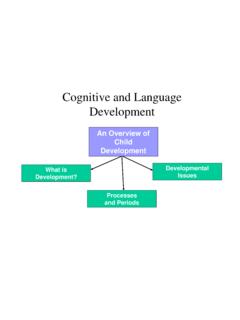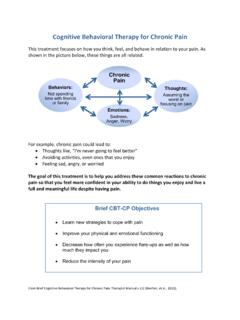Transcription of Cognitive development in adulthood
1 Adult Cognitive development : Dynamics in the Developmental WebKurt W. Fischer Zheng Yan Jeffrey B. StewartOutlineLadders and Webs: Meta-Metaphors of Adult Cognitive development ..1 Dynamic Ranges in the Web ..5 Multiple Levels of Adult Cognitive development ..6 Optimal and Functional and of Optimal Cognitive of Adult Skill Levels ..11 development beyond Abstractions?..15 development of Reflective Judgment and Moral Judgment..15 Dynamic Strands and Networks in the of Adult Identity in Darwin s development of the Theory of Evolution..26 Older Adults' Cognitive Backward and Forward Constructions in the Web..32 Backward Consolidation ..38 Conclusion: Richness and Complexity of Adult development .
2 41 References ..43 List of Tables and : The work on which this chapter is based was supported by grants from Mr. and P. Rose, Harvard University, and NICHD grant #HD32371. The authors thank NiraGranott, Jane Haltiwanger, Bruce Kennedy, Karen Kitchener, Arlyne Lazerson, James Parziale,and Samuel P. Rose for contributions to the theory and research. This chapter is dedicated tothe memory of Robbie Case and Samuel P. , K. W., Yan, Z., & Stewart, J. (2003). Adult Cognitive development : Dynamics in thedevelopmental web. In J. Valsiner & K. Connolly (Eds.), Handbook of developmentalpsychology. Pp. 491-516. Thousand Oaks, CA: Cognitive development :Dynamics in the Developmental WebKurt W.
3 Fischer Zheng Yan Jeffrey B. StewartAdulthood normally spans more than 60 years, starting from about age 20, and thecognitive changes during those years are vast. Accumulated evidence indicates that cognitivedevelopment in adulthood is rich, complex, and dynamic, perhaps even more so than in infancyand childhood, with many factors acting together in various contexts to produce systematic,dynamic variation. For instance, It can be observed that adults frequently show regressionperformances and move down to lower levels of Cognitive skill and then construct higher levels,instead of always following a simple forward progression. This kind of backward transitionphenomenon in adult Cognitive processes shows an interesting and important cognitiveadvancement, one that may seem frustrating and counter-intuitive to many intelligent adults.
4 Backward transition is just the tip of the large iceberg of complex Cognitive developmentin adulthood . In this chapter, we reframe adult Cognitive development dynamically,resynthesizing research findings to reveal the complex dynamics behind the variability in adultcognitive development , and reexamine the limitations of traditional Cognitive analyses (Fischer,1980b; Fischer & Bidell, 1998; Valsiner, 1991; van Geert, 1994). A constructed web (like thatbuilt in nature by a spider) serves as the meta-metaphor for development , and from the web weelaborate three important types of dynamic patterns in adult Cognitive development : dynamicranges, dynamic strands and networks, and dynamic constructions.
5 With these concepts, webegin to capture the richness and complexity of adult Cognitive development and to offer a newstory about what, how, and why adult Cognitive development takes place over and Webs: Meta-Metaphors of Adult Cognitive DevelopmentThe history of science shows that different meta-metaphors functioning as central mentalmodels have had tremendous impact on scientific thinking (for example, viewing the earth asthe center of the universe, seeing the spiral as the structure of DNA, considering the person asDynamics of Adult Cognitive development Page 2a digital computer). Likewise, different meta-metaphors drive fundamental views of adultcognitive development . We categorize two major types of meta-metaphors for adultdevelopment: ladders and webs, which engender different portraits of adult ladders characterize development as a simple fixed progression ,following monotonic change, with one step following another in a single direction.
6 As shown inFigure 1, the developmental ladder-like trajectory has at least three features: (1) developmentsimply follows a single straight line, (2) each step is fixed, following the previous step along theline, and 3) forward progression along the line is the sole form of development . Insert Figure 1: A Developmental LadderPiaget's (1983) Cognitive developmental model, as it is usually understood, is one of themost common ladder-like models of human Cognitive development (although Piaget himself hada more dynamic view, as in Piaget, 1975). According to this model, thinking progresses througha series of stages and then stops at the level of formal operations during adolescence. Manyscholars have built upon this Piagetian framework by extending the model vertically orhorizontally in adulthood , adding more stages or more unevenness across domains (Alexanderet al.
7 , 1990; Baltes, 1987; Basseches, 1984; Berg, 2000; Commons, Trudeau, Stein, Richards,& Krause, 1998; Dawson, 1999; Erikson, 1968; Gardner, 1983; Gruber, 1981; Kegan, 1982;King and Kitchener, 1994; Kohlberg, 1969,1984; Loevinger, 1976; and Sinnott, 1998). Thesemodels either have substantially expanded Piaget's model along the vertical dimension byadding higher Cognitive stages such as post-formal operations and advanced reflective thinking,or they have extended Piaget's model along the horizontal dimension by including morecognitive domains such as moral reasoning and self models that are grounded primarily in psychometric research, such asstandardized ability testing, often have acknowledged phenomena similar to Piagetian stages,Dynamics of Adult Cognitive development Page 3but have emphasized certain upward and downward general developmental trends associatedwith age on standardized tests of abilities (Baltes, 1987.
8 Birren, 1964, 1970; Horn & Cattell,1967; Craik, 1977; Craik & Salthouse, 1991; Horn, 1982; Salthouse, 1984, 1992; Sternberg,1985). Some abilities, such as crystallized intelligence, increase well into old age, while others,such as fluid intelligence, begin to decrease by early or middle various developmental models have substantially added to knowledge ofcognitive developmental changes and variations in adults, but all of them, to differing degrees,share an underlying ladder-like meta-metaphor. They treat adult Cognitive development , likechild Cognitive development , as a static progressive process unfolding along a series of fixedladder steps, either through stages or through linear ability scales.
9 In short, this meta-metaphordoes simplify complex developmental phenomena and sketch general developmental trends,but at the expense of neglecting, downplaying, and even misrepresenting the variability andrichness of adult Cognitive contrast, developmental webs portray adult Cognitive development as a complexprocess of dynamic construction within multiple ranges in multiple directions. As illustrated inFigure 2, the developmental web has at least three important features: (1) development occursin a complex multilevel range. (2) Developmental pathways undergo dynamic transformationthrough multiple strands or network links. (3) Multidirectional construction is the form ofdevelopment.
10 Insert Figure 2: A Developmental WebDynamic skill theory (Fischer & Bidell, 1998) analyzes development as involving aconstructed web that captures much of the rich variability in human behavior. Central to thevariability, it turns out, is the fact that activities take place in specific contexts. People do not actin a void. Growing adaptively in a dynamic world with various social, emotional, technological,and physical challenges means that behavior must fit the immediacy of the situation. For aDynamics of Adult Cognitive development Page 4description of development that aims at both rigor and honesty, these contexts cannot beignored. A web captures the interconnected complexity of skills in diverse contexts, as shown inFigure 2.










